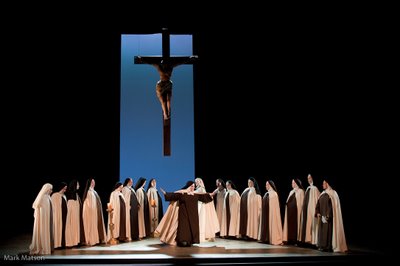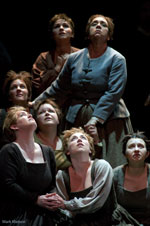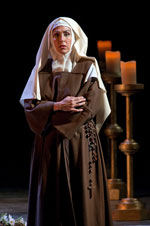Fear and Faith: Austin Lyric Opera Does Justice to Poulenc's Dialogues
Review by Paul E. Robinson

Classical Travels
THIS WEEK IN AUSTIN
In a world gone mad, it makes sense to be afraid, but it is the ultimate test of character to get beyond fear and take a stand for what one truly believes. This is the argument of Poulenc’s opera, Dialogues of the Carmelites. Premiered in 1957, it deals specifically with the fate of a group of Carmelite nuns during the French Revolution, but its theme, at once inspirational and unsettling, is universal and still relevant today.
 The new Austin Lyric Opera production of Dialogues of the Carmelites makes a powerful case for including this opera in the repertoire.
The new Austin Lyric Opera production of Dialogues of the Carmelites makes a powerful case for including this opera in the repertoire.
Dialogues moves very slowly and deliberately through its first hour or so – think Parsifal, which unfolds with similar deliberation – but if one allows oneself to be drawn into this world of faith and fear, the payoff is nothing less than devastating.
From a musical point of view, the opera is a peculiar amalgam of Debussy’s Pelléas and Stravinsky’s Oedipus Rex. The Dialogues score seems to meander and the orchestral sonorities are often acerbic, but Poulenc created exactly the musical language he needed to make this particular drama fresh and credible, just as he did in Gloria, which similarly brings something new and beautiful to liturgical music.
In this production, Austin Lyric Opera stage director Erik Einhorn and scenic designers Harry Frehner and Scott Reid bring Poulenc’s opera to life with a minimalist imaginative touch that exquisitely complements this music.
The sets and props are sparse and appropriate, placed and moved without obstructing the narrative flow. Lighting designer Shawn Kaufman also deserves credit for his deft employment of rear lighting. The use of black curtains, mysteriously opening and closing, served to underscore the spiritual elements of the drama. The production was created originally for the Calgary Opera, but what we saw in Austin was perfectly suited to the work and to the house.
The music onstage is dominated by the women (photo: above right) who sing the roles of the Carmelite nuns. Quite simply, they were first-rate. For an opening night, the level of ensemble precision was remarkable.
 It is somewhat unfair to single out individuals in such an ensemble effort, but Sheila Nadler as the dying Prioress in Act One – she has sung this role in more than twenty productions of the opera - gave a heart-rending performance, and Jennifer Check as the new Prioress sang with moving eloquence toward the end of Act Two. Emily Pulley (photo: right) as Blanche has the largest role and her personal crisis is at the heart of the opera. She gave a compelling performance and her voice is clearly first-class. Pulley was originally to have played Madame Lidoine, the new Prioress, but the change in casting proved quite satisfactory. Richard Buckley conducted with authority and sensitivity.
It is somewhat unfair to single out individuals in such an ensemble effort, but Sheila Nadler as the dying Prioress in Act One – she has sung this role in more than twenty productions of the opera - gave a heart-rending performance, and Jennifer Check as the new Prioress sang with moving eloquence toward the end of Act Two. Emily Pulley (photo: right) as Blanche has the largest role and her personal crisis is at the heart of the opera. She gave a compelling performance and her voice is clearly first-class. Pulley was originally to have played Madame Lidoine, the new Prioress, but the change in casting proved quite satisfactory. Richard Buckley conducted with authority and sensitivity.
Poulenc’s Dialogues of the Carmelites was Austin Lyric Opera’s last production of the season, following on equally fine presentations of Verdi’s Rigoletto and Rossini’s Cinderella. For next season general director Kevin Patterson has chosen Puccini’s La Bohème, Humperdinck’s Hansel and Gretel, and a real novelty, Chabrier’s The Star (L’Étoile).
Paul E. Robinson is the author of Herbert von Karajan: the Maestro as Superstar, and Sir Georg Solti: His Life and Music, both available at Amazon.com.
Photos by Mark Matson
 Classical Music Blogs
Classical Music Blogs 

Classical Travels
THIS WEEK IN AUSTIN
In a world gone mad, it makes sense to be afraid, but it is the ultimate test of character to get beyond fear and take a stand for what one truly believes. This is the argument of Poulenc’s opera, Dialogues of the Carmelites. Premiered in 1957, it deals specifically with the fate of a group of Carmelite nuns during the French Revolution, but its theme, at once inspirational and unsettling, is universal and still relevant today.
 The new Austin Lyric Opera production of Dialogues of the Carmelites makes a powerful case for including this opera in the repertoire.
The new Austin Lyric Opera production of Dialogues of the Carmelites makes a powerful case for including this opera in the repertoire.Dialogues moves very slowly and deliberately through its first hour or so – think Parsifal, which unfolds with similar deliberation – but if one allows oneself to be drawn into this world of faith and fear, the payoff is nothing less than devastating.
From a musical point of view, the opera is a peculiar amalgam of Debussy’s Pelléas and Stravinsky’s Oedipus Rex. The Dialogues score seems to meander and the orchestral sonorities are often acerbic, but Poulenc created exactly the musical language he needed to make this particular drama fresh and credible, just as he did in Gloria, which similarly brings something new and beautiful to liturgical music.
In this production, Austin Lyric Opera stage director Erik Einhorn and scenic designers Harry Frehner and Scott Reid bring Poulenc’s opera to life with a minimalist imaginative touch that exquisitely complements this music.
The sets and props are sparse and appropriate, placed and moved without obstructing the narrative flow. Lighting designer Shawn Kaufman also deserves credit for his deft employment of rear lighting. The use of black curtains, mysteriously opening and closing, served to underscore the spiritual elements of the drama. The production was created originally for the Calgary Opera, but what we saw in Austin was perfectly suited to the work and to the house.
The music onstage is dominated by the women (photo: above right) who sing the roles of the Carmelite nuns. Quite simply, they were first-rate. For an opening night, the level of ensemble precision was remarkable.
 It is somewhat unfair to single out individuals in such an ensemble effort, but Sheila Nadler as the dying Prioress in Act One – she has sung this role in more than twenty productions of the opera - gave a heart-rending performance, and Jennifer Check as the new Prioress sang with moving eloquence toward the end of Act Two. Emily Pulley (photo: right) as Blanche has the largest role and her personal crisis is at the heart of the opera. She gave a compelling performance and her voice is clearly first-class. Pulley was originally to have played Madame Lidoine, the new Prioress, but the change in casting proved quite satisfactory. Richard Buckley conducted with authority and sensitivity.
It is somewhat unfair to single out individuals in such an ensemble effort, but Sheila Nadler as the dying Prioress in Act One – she has sung this role in more than twenty productions of the opera - gave a heart-rending performance, and Jennifer Check as the new Prioress sang with moving eloquence toward the end of Act Two. Emily Pulley (photo: right) as Blanche has the largest role and her personal crisis is at the heart of the opera. She gave a compelling performance and her voice is clearly first-class. Pulley was originally to have played Madame Lidoine, the new Prioress, but the change in casting proved quite satisfactory. Richard Buckley conducted with authority and sensitivity.Poulenc’s Dialogues of the Carmelites was Austin Lyric Opera’s last production of the season, following on equally fine presentations of Verdi’s Rigoletto and Rossini’s Cinderella. For next season general director Kevin Patterson has chosen Puccini’s La Bohème, Humperdinck’s Hansel and Gretel, and a real novelty, Chabrier’s The Star (L’Étoile).
Paul E. Robinson is the author of Herbert von Karajan: the Maestro as Superstar, and Sir Georg Solti: His Life and Music, both available at Amazon.com.
Photos by Mark Matson

Labels: Austin Lyric Opera, classical travels, Dialogues of the Carmelites, Paul E. Robinson, Poulenc




1 Comments:
I recently traveled from Houston to attend the ALO production of Dialogues of the Carmelites. This is one of my favorite operas and I was really looking forward to it. I would like to comment on the staging of the final scene. I first felt misgivings when I saw the nuns line up across the back of the stage with no stairs in sight. My misgivings turned to dismay as they began to walk forward and then fall in place. I have NEVER sat dried eyed through this final scene, but ALO’s production left me not only unmoved but aggravated. Anyone who attended the performances must have noticed the lack of sobbing from the audience, which this powerful scene never fails to evoke, if staged properly. Here is the reason why: by having the nuns bravely mount the stairs to an unseen scaffold, their courage is magnified. How courageous is it to walk forward surrounded by your sisters? The real courage is in mounting the scaffold alone, to face your death alone, even as the voices of your sisters are stilled one by one. The audience in turn is inspired by their courage, even as we are horrified by their impending doom. Their fate, reinforced by the sound of the offstage guillotine falling (and I don’t believe Poulenc scored the sound of the blade rising again), becomes that much more dreadful in our imaginations. The entire scene, underscored by Poulenc’s powerful music, leads to a deep and emotional catharsis. When we can see them just stand there and fall, it’s just not as powerful. We cannot imagine them bravely going to the guillotine, because we see them NOT going to the guillotine. I can see the effect the director was going for with the bodies with outspread arms littering the stage (they’re martyrs – get it?), but it just didn’t work. Ultimately, and sadly, the entire opera was spoiled for me by the misguided staging of this final scene. Indeed, I believe the director did a disservice to the entire audience, as well as to Poulenc.
By Ann, At
May 5, 2009 4:24 PM
Ann, At
May 5, 2009 4:24 PM
Post a Comment
<$I18N$LinksToThisPost>:
Create a Link
<< Home